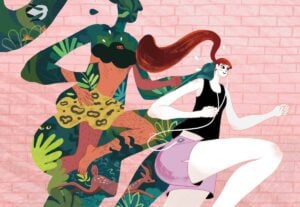We asked three illustrators three simple questions about personal branding, online identity and reputation.

Simona Čechová is a Slovakian illustrator based in Bratislava who studied advertising design and marketing in the United Kingdom.
There’s so much more to personal brand than logo, portfolio and client list. It is everything what illustrator does, says, writes, his personal trait, interests, beliefs and most importatnly the way he communicates all of this. This has much to say about one’s approach to life and work. It has a big hand in forming a personal brand. But I don’t like puting way too much emphasis on the words “personal branding”. It sure is good to know all the theory about building up a nice bubble around you (all the usual rules of branding still apply) but it must be sincere and frank. If you brand yourself in a certain way, not natural to you, after some time people can feel you’ve misinterpreted who you are.
 Cutting edge payroll software
Cutting edge payroll software
- Powerful and easy to use
- HMRC & RTI compliant
- Used by payroll pros
 The CRM platform to grow your business
The CRM platform to grow your business
- Great for entrepreneurs
- Powerful data analytics
- Manage sales and data
 Powerful web builder and advanced business tools
Powerful web builder and advanced business tools
- Great for startups
- Powerful web page builder
- E-commerce available
 Supercharged content planning
Supercharged content planning
- Great for marketing
- Better than lists or sheets
- Manage social media
 Create a new website in 10 minutes. Easy.
Create a new website in 10 minutes. Easy.
- Launch your website fast
- Powerful data intuitive
- No coding skills needed
You can be the best illustrator in the universe but when you keep your work in a drawer and no one knows about you, you will die unknown and poor. We are lucky to live in an era where sharing has never been easier. The internet is like a huge forum where everyone has a space to talk. Your online identity helps to humanize an anonymous face behind that computer screen. It can create deeper interest in who you are and what you can do. It’s good to set up a nice web site you can point people towards so that they can easily view your best work and find out a bit of information about you. This is a must-have I would say. It is the digital you. Also joining Facebook, Instagram and Behance was probably one of the best decisions. It’s propelled my career in a really positive direction. Sharing my work and enjoying other people’s work is the main reason for being on social media.
As for reputation, it all comes down to honesty. People appreciate it if they’re getting a true message. If you’re honest with yourself and you have fun with it, people definitely pick up on that. Most of my days are spent working, so if there’s anything of interest for me to photograph it’s probably something I’ve drawn but I also tend to show work in progress, behind the scenes images, work place and a little personal stuff like my cat or bees or some old drawings from kindergarten. From time to time it’s good to show yourself as well. I think people like to see what face is behind all the visuals. Everything tends to work as a piece of a greater story. I don’t separate my life from work. It has become one.
Kimberly Salt is a freelance illustrator based in New York. She primarily specializes in editorial illustration and her clients include The Guardian and The New York Times.
When I studied graphic design in school, we were taught that a brand signifies your gut feeling toward a company or name. As an illustrator, it would seem that one of the most apparent extensions of your brand is your style. Sometimes this can be very fluid, but I would say most of my illustrations carry the same feel of whimsy and movement (or try to, at least). When I first started putting my portfolio together, it felt crucial to have a distinct style to market as a unique selling point to clients. Now that I’m a bit further along, it seems necessary to push the limits of a style and evolve. I guess it’s somewhat of a balancing act – simultaneously ensuring that your clients’ trust is well placed and your work is not becoming stale.
Like a lot of other illustrators, I’m active on social media (some accounts more than others). I mostly just post work, process, and whatever stray thoughts I have on these. Each platform seems to have different but complementary ways of promoting work and interacting with other people. All of these channels point in the direction of my website, where my best work is housed and my contact info can easily be found.
I definitely try to keep my clients happy. I think it was Neil Gaiman who said that the formula for being a successful freelancer is doing good work, meeting your deadlines, and being easy to get along with. And if all three are not possible at once, two will do. Although I’m sometimes dissatisfied with my illustrations, I definitely make pleasantness and timeliness a priority.
Fonzy Nils (previously interviewed here) is an Italian illustrator based in London. His background is in architecture and some of his clients include Skylife Magazine and The Boston Globe.
I think that for a creative it is very important to build a personal image. It is a way to show who you are and which concepts are the basis of your vision to clients and to the world. Web site is one of the most important tools to communicate and share our works and we must do this in the simplest possible way. For me, personal branding is the approach that you use to explain what you do and why you do that and it’s important to build a recognizable image of yourself through various elements like social-networks profiles, style of communication and image that you share, everything must reflect your style and personality.
I manage my online identity using similar elements for my social networks like photos and posts and I like to share my thoughts and interact with people. Firstly I can’t see others as “followers “, I believe in reciprocal sharing and interactions. I like to share works in progress or sketches and it is very important for me to understand what my “web-friends ” think about me and what I do. I like to share often what happened in my professional life. I think that what we do is linked with who we are, thus I show myself through personal posts and photos, but I separately keep some aspects of my personal life that are not linked to my job and my creative ideas.
I try to show often what I do, I share my illustrations and I share posts regularly on my social-networks, I often update my personal website, I share my thinking with others. I think that it is important to have a clear vision of the journey that we want to follow and keep a coherent vision about all the elements that build our image. Basically I try to give a right space to self promotion every day.




